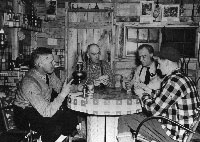Traveling Exhibits
Over the years, we have had a variety of traveling exhibits available. Below are the past exhibits and well as out current exhibit.
Current Traveling Exhibit
This exhibit is available to Maine libraries on the van delivery inter-library loan system. If you are interested in getting the exhibit at your library, please contact Katrina Wynn at katrina.wynn@maine.edu.
In 2016 the MFC launched a special exhibit highlighting the diversity of folk fiber arts in Maine entitled “Threads of Our Lives: Maine Folk Fiber Art.” The exhibit was made possible through a National Endowment of the Arts grant the MFC received in 2015. The exhibit features four 3’x7′ free-standing panels: “Wabanaki,” “Settlers,” “New Mainers,” and “Community.” The panels illustrate how Mainers from various backgrounds are carrying on their fiber art traditions. Click on the embedded links to learn more about the exhibit and check out the supplementary content for the exhibit as well: transcripts, audio, and videos.
 |
 |
Previous Traveling Exhibits
Remnants Of Our Lives: Maine Women and Traditional Textile Arts

This exhibit is based upon field work done to locate, identify and document traditional textile arts practices of Maine women. The ten large panels that make up the exhibit include photographs, text, and some of the original needlework from these women. This is a smaller rendition of the Remnants Of Our Lives exhibit that premiered at the Maine Center for the Arts in 1992. The interviews and examples of the quilting, knitting, sewing, and other needlework give insights into the perspective and social dimension of traditional artistic expression and are a tribute to the character, talents and mastery of contemporary women.
Women’s Work: A Century of Maine’s Experience

Only about 500 of the Center’s 8,000 photographs pertain to women, and many of these are formal family portraits. Within the remaining, relatively small, number of photographs are several surprising photographs of women in non-traditional occupations, such as lobstering, welding, repairing cars and sawing wood. This exhibit tells the story of the diversity of women’s work in the home, on the farm, for the family, in their own businesses, and for wages. The traveling exhibit is made up of a combination of oral histories, photographs and artifacts from the lives of working women. When the full Women’s Work exhibit was displayed at the University of Maine’s Student Union, it received generous praise and generated a great deal of discussion. There is also an online exhibit for your perusal.
Swedish Traveling Trunk

Students from the New Sweden Consolidated School told the creator of this exhibit what they would like their peers to know about the folklife and history of New Sweden. The students selected folklife genres of architecture, education, foodways, holidays and recreation for inclusion in the trunk. Materials in the trunk can be used independently or in conjunction with other classroom activities. The contents of the trunk includes an educator’s manual, artifacts, such as a straw goat, a Swedish flag, a cookie press, male and female traditional costumes, a video entitled New Sweden Little Folks, cassettes of Swedish music, books on the Delecalian Horse and Swedish language and grammar, a table top display and many more items. The artifacts come with labels and educators are also provided with sample questions and activities to make the Swedish traveling trunk a fun and educational tool for teaching about traditional Swedish folklife.
Maine Lumber Woods: Woodsmen Tell Their Stories

This attractive exhibit consists of seven large, easy to display panels with black and white photographs from lumbercamps and lumberwoods work in Maine. Along with the twenty-seven images are interesting and sometimes amusing stories from many of the Maine Folklife Center’s oral histories. The way the lumber workers lived, worked, ate and slept are brought to life in these rare photographs and their words bring us back to their rugged lives as woodsmen. “You sleep two in a bed…and…they didn’t take good care of their blankets…those heavy blankets…in the fall of the year lots of times they wouldn’t bother to laundry them…Next spring you’d have to crawl into them dirty old blankets.”
